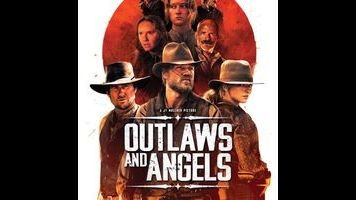There’s lots of nastiness but not much style in the brutal Outlaws And Angels

“I don’t need to put eyes on this sick shit,” mutters one of the outlaws in Outlaws And Angels, as he heads out the door of the small farmhouse where most of the movie takes place. Viewers of JT Mollner’s debut feature, which crosses the spaghetti Western with the home-invasion thriller, may share that sentiment. Set in 1887 New Mexico, the film declares its button-pushing intentions immediately, opening with an incongruously vulgar walk-and-talk between two young women that’s interrupted when one of them suddenly gets half of her face blown off by a stray bullet. Three bank robbers—Henry (Chad Michael Murray), Charles (Nathan Russell), and Little Joe (Keith Loneker)—flee the scene of their crime, heading for the Mexican border, and eventually wind up taking refuge in the home of the Tildon family, where Henry takes a special interest in Florence (Francesca Eastwood), the younger of two daughters. As it turns out, Florence has reason to be rather shockingly cooperative, and blood soon flows freely.
Mollner expanded Outlaws And Angels from his 2009 short, “Henry John And The Little Bug,” which helps explain why this two-hour movie feels like it’s belaboring maybe 20-30 minutes’ worth of story. Luke Wilson and Steven Michael Quezada play a couple of bounty hunters on the outlaws’ trail, for example, and the film cuts to them throughout (at what seems like random intervals), but they could be excised entirely without anyone so much sensing a void. (That would be a blessing when it comes to Wilson’s occasional philosophical voice-over narration, which makes Terrence Malick’s wooliest passages sound like James M. Cain.) What narrative there is exists primarily as a pretext to revel in sheer nastiness, which Mollner often aestheticizes via slow motion and/or classical piano accompaniment (though not Ludwig Van). Essentially, this is Last House On The Left meets Little House On The Prairie—not quite as gory as that mashup suggests, perhaps, but with a similarly singleminded, empty-headed focus on violation and revenge.
Quentin Tarantino gets away with a certain amount of gleeful sadism because he has a superb eye, writes great dialogue, and inspires brilliant performances. Mollner can lay partial claim to that last item, in that he’s created a fine showcase for Eastwood (daughter of Clint and Frances Fisher; the latter appears here in a tiny role), who makes Florence—or “Little Bug,” as Henry calls her—a truly unpredictable wild card, turning horrific circumstances to her own equally horrific advantage. (It’s not Eastwood’s fault that she’s 22, and looks it, whereas Florence is supposed to be 15.) Widescreen compositions aren’t yet this director’s forte, however, and while his decision to shoot on 35mm pays dividends within deep shadows, he (or his cinematographer, Matthew Irving) hasn’t figured out how to light actors so that reflections don’t bounce off of their shiny foreheads. (Or maybe that’s a makeup issue. Either way, it’s distracting.) Mollner is also prone to toss in dramatic zooms that serve no purpose apart from a vague “retro” feel.
The main problem with Outlaws And Angels, though, is that it lacks either a sense of authenticity or a streak of playfulness to give shape to its relentlessly ugly worldview. Last year’s sleeper horror-Western, Bone Tomahawk, offers both, and is a pleasure to watch even during long stretches when nothing much is happening, either plot-wise or gore-wise. This film, despite what sounds like well-researched period dialogue and a corresponding attention to 19th-century visual detail, comes to life only when its characters are being shot, bludgeoned, raped, and terrorized. One tough-to-endure scene observes Florence’s Bible-thumping mother (Teri Polo, giving a boldly unhinged performance that sometimes crosses the line into camp) being digitally penetrated at length by Charles in the middle of the night, as the film cuts back and forth between his leering expression and her terror—and Charles is the outlaw who takes a powder later on, saying he doesn’t want to see what’s coming next! Those who don’t relish suffering will likely choose to join him.